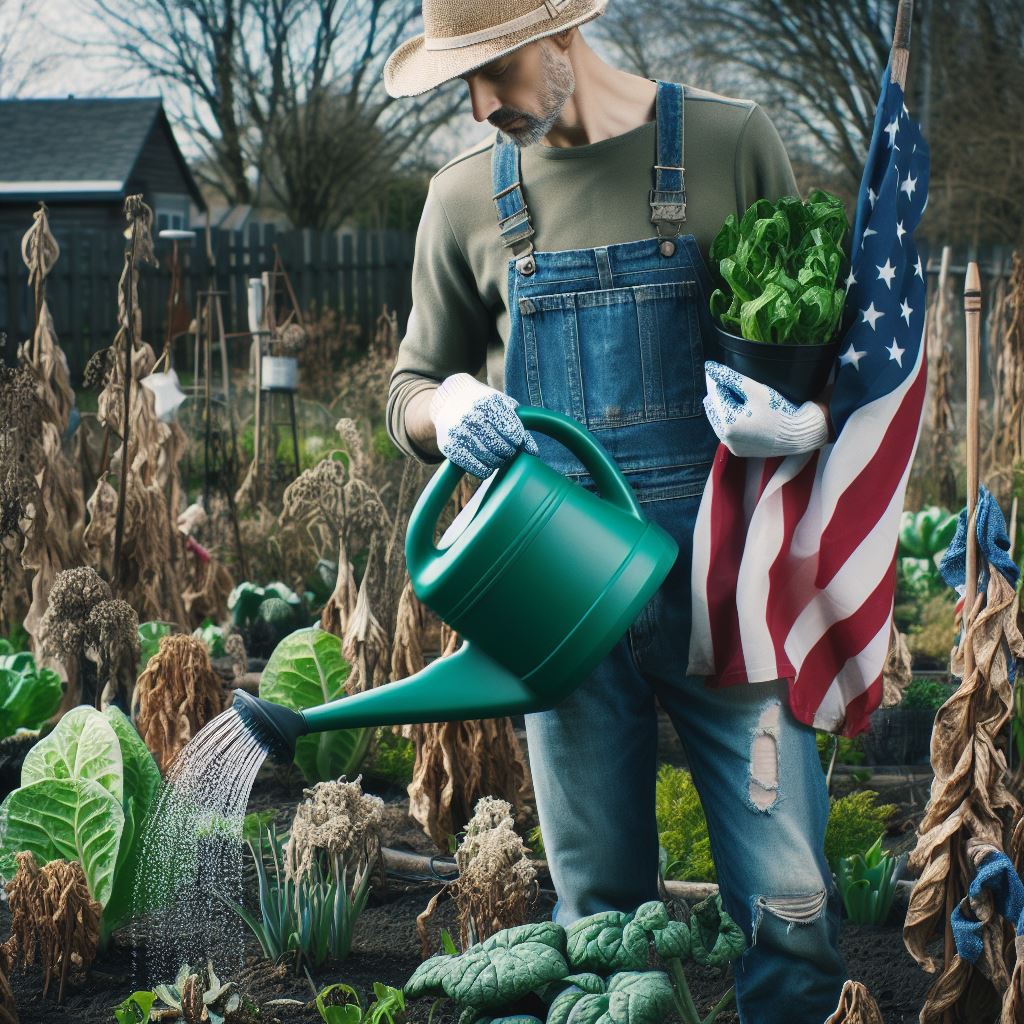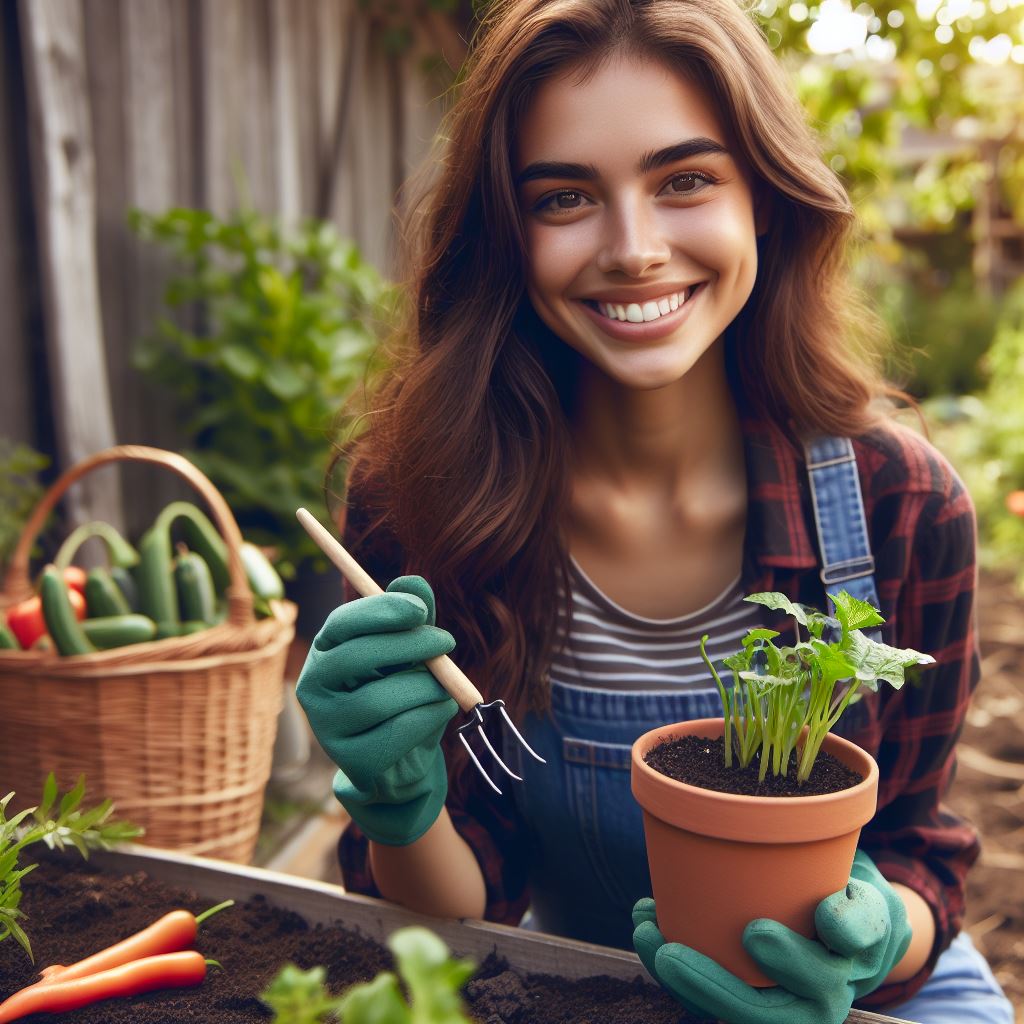Introduction
Gardening in Drought: Tips for Water Economy underscore the critical importance of water conservation in gardening during dry spells, emphasizing the significance of comprehending its essential role.
With water scarcity becoming a global concern, it is essential to explore ways to conserve water in gardening.
In this blog post, we will discuss various tips for water economy in gardening during a drought.
By implementing these strategies, you can minimize water usage while maintaining a thriving garden.
Let’s delve into the following tips that will help ensure efficient water usage:
Choose Drought-Tolerant Plants
Benefits of selecting plants that can withstand drought conditions
Choosing plants that can withstand drought conditions has numerous benefits for gardeners.
These plants are not only able to survive with minimal water, but they also require less maintenance compared to other plants.
By selecting drought-tolerant plants, you can have a beautiful garden while conserving water and reducing your gardening chores.
Here are some popular drought-tolerant plants worth considering for your garden:
- Succulents: These water-storing plants come in a variety of shapes, sizes, and colors, making them perfect for adding texture and interest to your garden. Examples include echeveria, sedum, and aloe vera.
- Lavender: Aside from its delightful fragrance, lavender is a versatile plant that thrives in dry conditions. It also attracts bees and butterflies, making it beneficial for pollinators.
- Russian Sage: With its silver-gray foliage and stunning purple flowers, Russian sage is a showstopper in any garden. It requires little water and is quite hardy.
- Yarrow: This perennial offers clusters of yellow, pink, or white flowers atop fern-like leaves. Yarrow is tough, attracts beneficial insects, and requires minimal water once established.
- California Poppy: Known for its vibrant orange blooms, the California poppy is a hardy plant that self-seeds easily. It thrives in dry conditions, making it ideal for water-wise gardens.
Tips for planting and caring for drought-tolerant plants
When planting and caring for drought-tolerant plants, keep the following tips in mind:
- Choose the Right Spot: Ensure your plants receive adequate sunlight and have well-draining soil. Insufficient sunlight or waterlogged soil may harm your drought-tolerant plants.
- Mulching: Apply a layer of mulch around the base of your plants to help retain moisture, suppress weeds, and regulate soil temperature.
- Water Smartly: Even though these plants are drought-tolerant, they still need water to establish themselves. Ensure newly planted drought-tolerant plants receive sufficient water until they establish deep roots.
- Irrigation Techniques: Consider using drip irrigation or soaker hoses to deliver water directly to the plant’s roots while minimizing water loss through evaporation.
- Monitor Soil Moisture: Check the soil moisture regularly to ensure your plants are neither overwatered nor underwatered. Stick your finger into the soil about an inch deep; if it feels dry, it’s time to water.
- Group Plants with Similar Water Needs: By grouping plants with similar water requirements together, you can avoid overwatering some and underwatering others.
- Regular Pruning: Prune your plants regularly to encourage healthy growth and improve air circulation, preventing diseases caused by excessive humidity.
In essence, selecting drought-tolerant plants for your garden is a wise and practical choice.
These plants not only survive in dry conditions but also add beauty and interest to your garden.
Remember to choose the right spot, provide adequate water during establishment, and use appropriate irrigation techniques.
By doing so, you can create a water-wise garden that conserves water and requires minimal maintenance. Happy gardening!
Read: Drip Irrigation: Small Farm Water-Saving Guide
Transform Your Agribusiness
Unlock your farm's potential with expert advice tailored to your needs. Get actionable steps that drive real results.
Get StartedMulching
Mulching is a crucial technique in water conservation during a drought.
It helps retain moisture in the soil, reducing the need for frequent watering.
Here are some benefits of mulching and tips for successfully applying mulch in your garden:
Importance of Mulching
- Retains Moisture: Mulch acts as a protective barrier, reducing evaporation and keeping the soil moist for a longer duration.
- Controls Weeds: Mulch helps suppress weed growth, preventing them from competing with your plants for water.
- Regulates Soil Temperature: Mulching insulates the soil, keeping it cooler during hot summer days and warmer during cool nights.
- Prevents Erosion: Mulch prevents soil erosion by reducing the impact of rainfall and wind on the bare soil.
Types of Mulch and Their Benefits
- Organic Mulch: This type of mulch includes materials like wood chips, straw, leaves, and grass clippings. It improves soil structure as it breaks down and enriches the soil with nutrients.
- Inorganic Mulch: Examples include pebbles, stones, and plastic sheets. These types of mulch are long-lasting and do not decompose like organic mulch. They are ideal for arid regions where water conservation is crucial.
- Living Mulch: Using low-growing ground covers or clover as mulch can provide extra benefits. They help retain moisture and also act as a green manure when eventually incorporated into the soil.
Proper Application of Mulch
- Prepare the Soil: Before applying mulch, ensure the soil is adequately watered and free from weeds.
- Determine the Thickness: Apply a layer of mulch about 2 to 4 inches thick. Thicker mulch will have better water retention.
- Mulch Placement: Keep mulch at least 2 to 3 inches away from plant stems to prevent rot and pest problems.
- Mulch Maintenance: Replenish mulch as needed to maintain the desired depth and effectiveness.
Additional Tips for Successful Mulching
- Water Before Mulching: Moistening the soil before applying mulch helps create a moist environment, promoting water retention.
- Use Organic Mulch Additives: Consider adding organic mulch enhancers like compost or well-rotted manure to boost soil fertility.
- Avoid Thick Mulch Around Woody Plants: Thick mulch around trees and shrubs can create a habitat for rodents and lead to trunk rot.
- Monitor Mulch Depth: Over time, organic mulch decomposes. Keep an eye on the depth and add more mulch when necessary.
In a nutshell, mulching is an excellent technique for water economy in drought-stricken gardens.
By choosing the appropriate mulch and applying it correctly, you can conserve water, control weeds, regulate soil temperature, and prevent erosion.
Implementing mulch in your garden is a sustainable step towards a luscious and water-efficient landscape.
Read: Rainwater Harvest: A Boon for Urban Gardeners
Proper Watering Techniques
During a drought, efficient watering practices become crucial in maintaining a thriving garden.
By employing the right methods, you can ensure that your plants receive adequate hydration while conserving water.
The Importance of Efficient Watering Practices
- Efficient watering practices minimize water waste during a drought.
- Appropriate watering techniques help plants withstand water scarcity and thrive.
- By conserving water, you contribute to the overall sustainability of your garden.
Different Methods of Watering and Their Benefits
There are several effective methods of watering your plants, each offering unique advantages:
- Drip Irrigation: Drip irrigation delivers water directly to plant roots, reducing water loss due to evaporation. It is highly efficient and conserves water.
- Soaker Hoses: Soaker hoses release water slowly and evenly along their entire length. They minimize runoff and ensure deep root penetration.
- Sprinkler Systems: Sprinkler systems are suitable for larger areas. However, they may lead to water loss through evaporation or runoff if not used correctly.
Determining When and How Much to Water
- Check the soil moisture by sticking your finger about an inch into the soil. If it feels dry, it’s time to water.
- Water early in the morning or late in the evening when temperatures are cooler to minimize evaporation.
- Consider the specific water needs of each plant type and adjust watering accordingly.
- Use a rain gauge to measure rainfall and only supplement if the plants require additional water.
Tips for Avoiding Water Runoff and Evaporation
- Avoid watering on windy days to prevent water drift and uneven distribution.
- Apply a layer of mulch around plants to retain moisture and inhibit weed growth.
- Group plants with similar water requirements together to ensure efficient watering.
- Inspect your irrigation system regularly for leaks, blockages, or malfunctioning components.
- Direct water to the base of plants and avoid spraying foliage to reduce evaporation.
By following these proper watering techniques, you can maximize water efficiency in your garden and help your plants thrive, even during a drought.
It is essential to stay mindful of water conservation practices and adjust your watering methods based on local conditions and plant needs.
Remember, maintaining a healthy garden in a drought requires being resourceful and implementing efficient watering practices.
Conserve water, save your plants, and contribute to a more sustainable future. Happy gardening!
Transform Your Agribusiness Online Presence
Stand out with compelling content tailored to engage your audience and drive results. From blog posts to social media, we’ll create what your business needs to grow.
Get StartedRead: Smart Watering: Techniques for Small-Scale Farms

Soil Management
In times of drought, having quality soil that can retain water is crucial for successful gardening.
Here are some tips to improve soil structure and water-holding capacity:
Importance of Quality Soil
- Good soil structure helps plants access nutrients and water during dry periods.
- Healthy soil retains moisture for longer periods, reducing the need for frequent watering.
- Adequate soil moisture promotes root development and overall plant health.
Tips for Improving Soil Structure
- Add organic matter like compost or well-rotted manure to enhance soil structure.
- Avoid compacting the soil by using raised beds or pathways to minimize foot traffic.
- Use cover crops to improve soil health and prevent erosion.
Proper Soil Preparation
- Before planting, ensure the soil is well-drained and not waterlogged.
- Amend the soil with organic matter, such as compost or peat moss, to improve its water-holding capacity.
- Remove any weeds or debris that might compete with plants for water.
Techniques for Preserving Soil Moisture
- Mulching around plants with organic materials like straw or wood chips helps retain moisture.
- Water deeply but infrequently to encourage plant roots to grow deeper in search of water.
- Use drip irrigation or soaker hoses to deliver water directly to the plant’s root zone.
- Avoid over-watering, as it can lead to shallow root growth and water wastage.
Taking care of your soil is key to successful gardening during a drought.
By improving soil structure and implementing proper moisture-preserving techniques, you can minimize water usage while still growing healthy, vibrant plants.
Read: Water-Wise Gardening: Simple Steps for Hobbyists
Grouping Plants with Similar Watering Needs
Grouping plants with similar watering needs together in your garden can lead to various advantages.
Not only does it promote water economy, but it also enhances the health and growth of your plants.
Advantages of grouping plants with similar water requirements together
Here are some advantages of this practice:
- Water Efficiency: Grouping plants with similar watering needs allows you to create watering zones according to their requirements. This ensures that each plant receives the appropriate amount of water, resulting in water efficiency.
- Resource Conservation: By grouping plants that need less water together, you can conserve water resources and contribute to a sustainable environment. This is especially beneficial in drought-prone areas where water scarcity is a major concern.
- Reduced Water Waste: When plants with different water needs are mixed together, overwatering or underwatering may occur. Grouping plants with similar watering needs prevents water waste by providing the right amount of water to each plant, minimizing runoff and evaporation.
Tips for planning and organizing the garden based on watering needs
Planning and organizing your garden based on the watering needs of your plants is essential.
Consider the following tips to create a well-structured garden:
- Research and Categorize: Start by researching the water requirements of different plants. Categorize them into high, moderate, and low water needs. This will help you determine which plants can be grouped together.
- Mapping the Garden: Create a garden map or layout, marking the areas where plants with similar watering needs will be grouped. Consider factors like sun exposure, soil type, and drainage when planning the layout.
- Watering Zones: Divide your garden into different watering zones based on the water requirements of each group of plants. This will enable you to irrigate efficiently and avoid over or underwatering.
How to create efficient irrigation zones for watering convenience
Now, let’s discuss how to create efficient irrigation zones for watering convenience:
- Install Drip Irrigation: Drip irrigation is an ideal technique for watering grouped plants with similar needs. It delivers water directly to the root zone, minimizing evaporation and ensuring efficient water utilization.
- Use Soaker Hoses: Soaker hoses provide slow and steady water release, reducing runoff and promoting deep root penetration. Place them strategically within watering zones for effective water distribution.
- Timer-controlled Systems: Install timer-controlled irrigation systems to automate the watering process. This ensures consistency in providing the right amount of water to each zone, even when you’re away.
By implementing these tips, you can create an organized garden that optimizes water usage and promotes healthy plant growth.
Besides, grouping plants with similar watering needs together offers convenience in maintenance and eliminates the guesswork of watering.
Unlock Farming Insights for Growth
Make smarter farming decisions with detailed reports on market trends, weather patterns, and soil health tailored to your farm's success. Boost productivity with actionable data.
Get ReportRemember, a well-planned garden that considers the watering needs of plants promotes both water conservation and gardening success.
Collecting and Recycling Water
Benefits of collecting and using rainwater
Rainwater harvesting is an effective way to conserve water and reduce the water bill.
One benefit is that rainwater is free and readily available, reducing reliance on municipal water supplies.
To harvest rainwater, you can use rain barrels, which are placed under downspouts to collect the water.
Another method is using a rainwater collection system, where gutters direct rainwater into a storage tank.
It’s important to have a filter system to remove debris and contaminants from collected rainwater.
Tips for proper storage and utilization of collected rainwater
Proper storage is essential to prevent evaporation, contamination, and mosquito breeding.
Install a tight-fitting screen on the barrel or tank to keep out insects and prevent accidents.
Connect a hose or use a watering can
To utilize the collected rainwater, connect a hose or use a watering can to water the plants.
Rainwater can also be used for washing gardening tools or even for flushing toilets.
In addition to rainwater, other sources of water can be recycled in the garden.
Use a bucket
Use a bucket to collect excess water from washing vegetables, and use it to water plants.
Graywater from non-toxic household activities like laundry or dishwashing can be reused as well.
Avoid using water with harsh chemicals or detergents, as it may harm plants and the soil.
Consider using a drip irrigation system
Consider using a drip irrigation system to efficiently water plants, reducing water waste.
Mulching around plants helps retain moisture and reduces the need for frequent watering.
Choose drought-tolerant plants that require less water and can survive in dry conditions.
Efficiently water the garden by watering early in the morning or late in the evening, when evaporation is minimal.
Remember to regularly check for leaks, fix them promptly, and avoid water wastage.
Watering deeply and less frequently encourages plants to develop deep roots and become more resilient.
Conserving water in the garden not only helps during droughts but also protects the environment.
By reducing water usage, we help conserve precious freshwater resources and protect ecosystems.
Educate others about water conservation and the benefits of rainwater harvesting in gardens.
By implementing these tips, we can create a sustainable and water-efficient garden.
Start collecting rainwater today and make a positive impact on the environment and your wallet.
Learn More: Herbs & Greens: Hydroponic Gardening Easy
Conclusion
Water economy plays a crucial role in gardening during a drought.
By implementing the tips discussed in this blog post, such as mulching, using drip irrigation, and choosing drought-tolerant plants, gardeners can conserve water effectively.
It is important for readers to try out these techniques and share their experiences to foster a community of water-conscious gardeners.
As we wrap up, let’s remember the significance of water conservation in gardening during droughts for the health of our landscapes and the sustainability of our environment.
Together, we can make a difference in preserving this precious resource for future generations.




